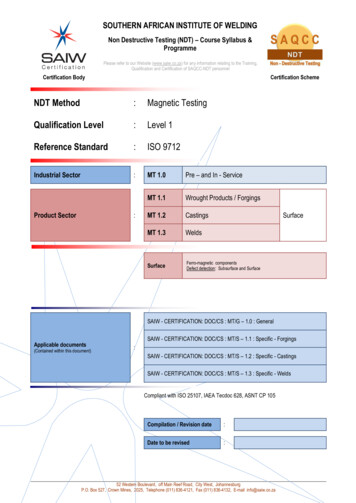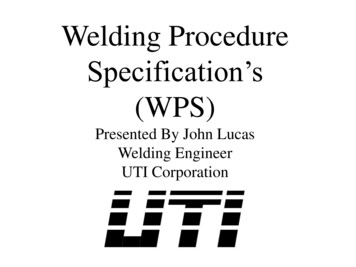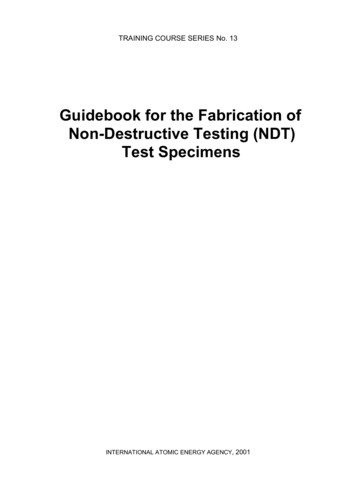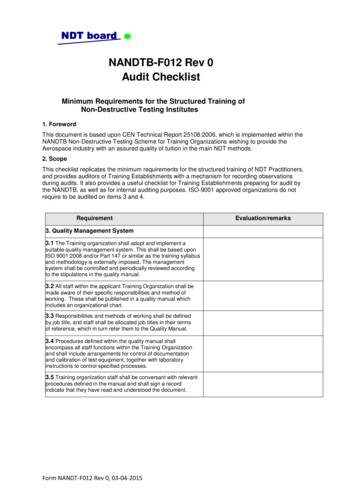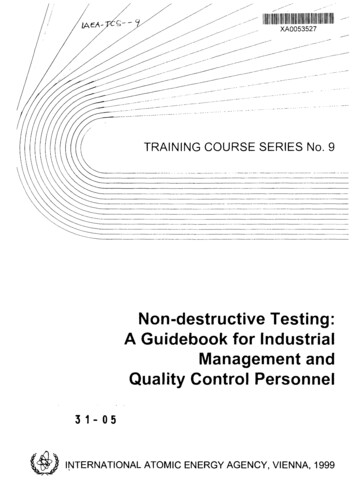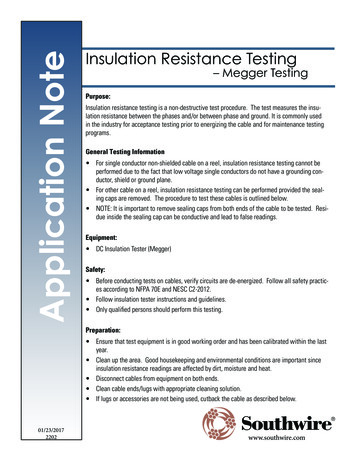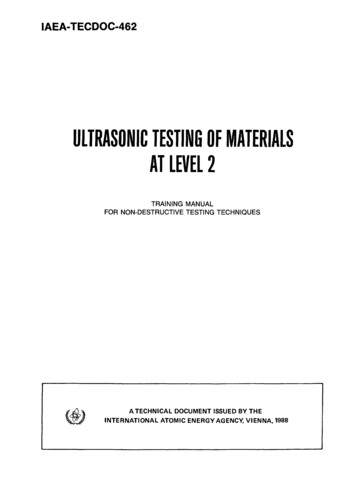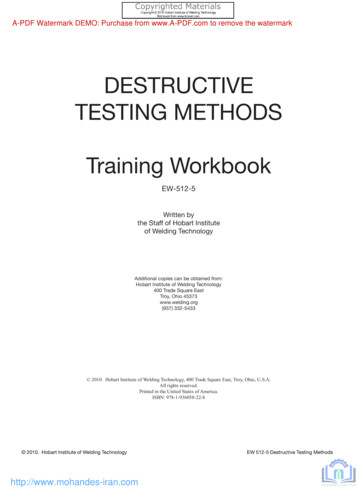
Transcription
A-PDF Watermark DEMO: Purchase from www.A-PDF.com to remove the watermarkDESTRUCTIVETESTING METHODSTraining WorkbookEW-512-5Written bythe Staff of Hobart Instituteof Welding TechnologyAdditional copies can be obtained from:Hobart Institute of Welding Technology400 Trade Square EastTroy, Ohio 45373www.welding.org(937) 332-5433 2010. Hobart Institute of Welding Technology, 400 Trade Square East, Troy, Ohio, U.S.A.All rights reserved.Printed in the United States of America.ISBN: 978-1-936058-22-8 2010. Hobart Institute of Welding Technologyhttp://www.mohandes-iran.comEW 512-5 Destructive Testing Methods
TABLE OF CONTENTSTOPICPAGEGlossary of Welding TermsiiiIntroduction to Destructive Testing Methods1Tension Testing6Impact Testing16Guided Bend Testing22Nick Break Testing29Fillet Weld Break Testing34Etch Testing40 2010. Hobart Institute of Welding TechnologyEW 512-5 Destructive Testing Methodsiihttp://www.mohandes-iran.com
TOPIC 1INTRODUCTION TO DESTRUCTIVE TESTING METHODSOBJECTIVETo know the mechanical properties of metals and welds and the type of tests used to evaluate these properties.INTRODUCTIONDestructive testing is an evaluation process ofa weld or base metal specimen. Evaluationtakes place during and/or after the destructionof the specimen. It is a function performed byquality control to measure properties of metalsand welds.The term weld soundness is commonly usedto describe the degree of freedom fromdiscontinuities contained with a weld. Cracks,inclusions, porosity and lack of fusion reduceweld soundness, which may prevent the weldfrom performing in service. In addition to weldsoundness, the mechanical, chemical andmetallurgical properties of the welded joint areimportant to insure reliability of the weldmentin service.In design, materials are selected to providethese properties. The process of weldingmust enable the materials to maintain theseproperties through development and useof a proven procedure. Welding codes usea variety of destructive testing methods toevaluate materials so that design performancerequirements can be met. 2010. Hobart Institute of Welding TechnologyEW 512-5 Destructive Testing Methods1http://www.mohandes-iran.com
Destructive testing processes are alsospecified to evaluate the results of weldingprocedures.Procedure and welders arequalified by destructive tests.Destructive testing can also be used to spotcheck the quality of production weldments.This is commonly known as work sampling.MECHANICAL PROPERTIESThe most important mechanical propertiesof welded joints include strength, ductility,toughness and hardness.One important measure of strength is thematerial’s ultimate tensile strength. This isdetermined by subjecting weld metal or a weldjoint to a pulling load until it fails. The maximumstress developed is a good indication of theamount of load the material can sustain. Yieldstrength is another important measurement ofthe material’s load carrying capacity. The yieldstrength is the stress at which the material willchange permanently in dimension, usuallylength, and cross sectional area. 2010. Hobart Institute of Welding TechnologyEW 512-5 Destructive Testing Methods2http://www.mohandes-iran.com
Ductility is the property of a metal which allowsit to be drawn or stretched without fracture. Aductile material can be bent. A material whichis not ductile is referred to as brittle.Toughness is the ability of a material to sustainsudden shock loading at various temperatureswithout failure. The energy absorbed by thespecimen will vary depending on temperature.For example, steel will possess lower toughnessproperties as the temperature is reduced.The property of hardness is defined as themetal’s resistance to indentation from theforce of a hardened substance. Hardnessof metals is measured by forcing a hardenedsteel ball or a diamond into the surface of ametal. The Brinell, Rockwell and Vickers testsare commonly used to evaluate this property.CHEMICAL PROPERTIESDestructive testing also includes chemicaltests. Welded joints may be cut to removesections for analysis of alloying elements. 2010. Hobart Institute of Welding TechnologyEW 512-5 Destructive Testing Methods3http://www.mohandes-iran.com
Specialized equipment in laboratory conditionsis used to evaluate chemical composition. Forexample, spectrographic analysis could beused. Chemical composition is important toweldments which require corrosion resistance.Chromium and nickel contents and carbideformations are analyzed to determine theweldment’s ability to perform in service.One method of determining metallurgicalstructures is through etching the welded joint.This method consists of cutting a specimen,polishing the cut surface, applying an etchingacid, and visually inspecting the etched surface.Variations of the process include viewingthe etched surface with different degreesof magnification. This form of examinationis known as macro or micro examination,depending upon the magnification used.CONCLUSIONDESTRUCTIVE TESTINGDestructive testing can be a very effective toolto determine weld quality if:1) The destructive testing procedure isestablished.2) Specimens are properly selected andprepared.3) Results are evaluated in accordancewith prescribed standards.ESTABLISH PROCEDURESELECT AND PREPARE SPECIMENSEVALUATE RESULTS 2010. Hobart Institute of Welding TechnologyEW 512-5 Destructive Testing Methods4http://www.mohandes-iran.com
TOPIC 1REVIEW QUESTIONS1. List the three major groups of properties evaluated by destructive testing:2. Name three functions of destructive testing:3. Name the four most common mechanical properties related to welding:4. The process of selecting production weldments for test is called: 2010. Hobart Institute of Welding TechnologyEW 512-5 Destructive Testing Methods5http://www.mohandes-iran.com
TOPIC 2TENSION TESTINGOBJECTIVETo know the procedure used to perform tensile tests and the results derived from the test.INTRODUCTIONThe tension test is used to determine thebehavior of a material as it is pulled graduallybeyond the breaking point. It is one of the mostvaluable destructive tests because it providesdata on strength, ductility and soundness ofbase metal and weld metal.ALL WELD METAL TENSION TESTAll weld metal and all base metal specimensare used to determine the strength and ductilityproperties of material.These tests are commonly used to classifybase metal and weld metal to nationalstandards. For example, filler metals mustmeet minimum mechanical properties to beclassified to the American Welding Societyfiller metal identification system.All weld metal specimens are machined fromthe center portion of a weld test coupon.It must consist entirely of weld metal in thereduced section of the specimen. 2010. Hobart Institute of Welding TechnologyEW 512-5 Destructive Testing Methods6http://www.mohandes-iran.com
The ends of the specimen are shaped to fit thejaws of the testing equipment in use. ion of test specimens which must beconsidered.The reduced section of the specimen isnormally tapered about .005-inch from the endsto the center. This allows the fracture to occurapproximately in the center of the specimenwhere it is the thinnest.The diameter at the center of the tensilespecimen will vary depending on materialthickness and code requirements. The finishedsurface should be smooth enough to preventpremature failure. A rough surface couldinitiate a fracture in an undesirable location.The procedure for testing all weld metal or basemetal tensile specimens will be discussed first.It is essential that the applicable specification bereviewed to determine the exact procedure. A.505-inch specimen will be used for illustration. 2010. Hobart Institute of Welding TechnologyEW 512-5 Destructive Testing Methods7http://www.mohandes-iran.com
The five-o-five specimen is marked with acenterpunch at two points, two inches apart.This is known as gage length. The originalgage length of two inches is recorded for uselater to calculate ductility.The specimen is secured in the jaws of thetension machine. A strain gage is attachedto the specimen to detect changes in lengthwhen force is applied.The equipment operator begins the pullingprocess by allowing the machine to applypounds of force (load) to the specimen.As the force is applied, stress develops in thespecimen. The stress is equal to the forceapplied divided by the cross sectional area ofthe specimen. 2010. Hobart Institute of Welding TechnologyEW 512-5 Destructive Testing Methods8http://www.mohandes-iran.com
The area of a five-o-five diameter specimen isdetermined by squaring the diameter and thenmultiplying by Ȇ or 3.14. This value is dividedby four. The answer is .2 square inches.If the force applied to the specimen is fivethousand pounds, the stress becomes 25,000pounds per square inch (psi).As the force is applied, the specimen begins tostretch or elongate. This is commonly referredto as strain. The units for strain are inch perinch. This is the amount of increase in lengthper inch of gage length.Some tensile equipment is designed withcharts to plot the stress in relation to the strain.The gage attached to the specimen detectsthe elongation which is used by the equipmentto plot the strain. 2010. Hobart Institute of Welding TechnologyEW 512-5 Destructive Testing Methods9http://www.mohandes-iran.com
The curve which is plotted is called a stressstrain curve. In the lower part of the curve, thestress is proportional to the strain. Under theseloading conditions, the material is an elasticstate. This means if the load is removed, thematerial will return to its original length.As the load continues to increase, the materialeventually reaches its elastic limit at point A. Atpoint A, the material begins to yield. When thematerial yields, it will permanently elongate,sometimes referred to as plastic deformation.Under these loading conditions, the material isin a plastic state. If the load is removed now,the material will not return to its original length.The point at which the material is permanentlyelongated is called the yield point. The yieldpoint is defined as the load that causes amarked increase in strain without increase instress.In many cases, the yield point is difficult todetermine. Because of this, yield strength ismore commonly used to describe the point ofyielding, or permanent deformation.The yield strength is determined by drawing astraight line parallel to the straight portion ofthe curve. 2010. Hobart Institute of Welding TechnologyEW 512-5 Destructive Testing Methods10http://www.mohandes-iran.com
This is described an as offset method sincethe distance between the lines is a percentageof the original gage length. The point at whichthe offset line crosses the original curve is theyield strength.If the intersection occurred at a load of eightthousand pounds, we can divide the load bythe cross sectional area to determine the yieldstrength. In this case, it is 40,000 pounds persquare inch.After the material has yielded, the strain gageis usually removed to prevent damage to thegage when the material ruptures.As addition load is applied, it reaches amaximum value called the ultimate tensilestrength. A noticeable reduction in area andincrease in length will occur as the load isincreased.By dividing the maximum load by the originalcross sectional area, the ultimate tensilestrength can be calculated. 2010. Hobart Institute of Welding TechnologyEW 512-5 Destructive Testing Methods11http://www.mohandes-iran.com
After the ultimate strength is achieved, theactual stress may decrease as the materialfails. This is due to the significant reductionof area which occurs in the later stages of thetest.The broken specimen is used to calculateductility through percent elongation andpercent reduction of area.The percent of elongation is determined bymeasuring the final length between the punchmarks.The difference between the final length and theoriginal length is divided by the original lengthfollowed by multiplying by 100. A higherpercentage indicates greater ductility.To measure reduction of area, measure thesmallest cross section of the broken specimen.Calibrated micrometers or calipers are used tomake the measurement. 2010. Hobart Institute of Welding TechnologyEW 512-5 Destructive Testing Methods12http://www.mohandes-iran.com
The difference between the original and finalarea is divided by the original area and then theresult is multiplied by 100. A higher percentageindicates greater ductility.The all weld metal tensile test is mostcommonly used to specify and classify weldingconsumables. However some welding codesalso require this test to qualify procedures withspecial processes such as electroslag andelectrogas welding.REDUCED SECTION TENSION TESTThese tests are commonly used by publishedwelding codes to qualify welding procedures.Usually the test specimens are removed fromplate and pipe welds transverse to the directionof welding. The type, size and number of testspecimens will depend on code requirements.Once the specimens are removed, they aremachined to the required dimension. The termreduced section is used since the middle ofthe specimen is thinner than the ends. 2010. Hobart Institute of Welding TechnologyEW 512-5 Destructive Testing Methods13http://www.mohandes-iran.com
The reduced section tensile is placed in thetension machine and pulled to failure. Thestrain gage is normally not used to performthese tests.Most codes require the ultimate tensile strengthrecorded in the test to be equal to or greaterthan the minimum of the specified tensile rangeof the base metal welded.Full sections may be required on thin materialor small diameter pipe where it becomesdifficult to remove the test specimen.It is important to review the applicablespecification to determine the proper procedureand type of coupon based on the qualificationto be performed. The tensile test is most oftenused to verify materials and procedures prior toproduction or construction, although it could beused on random sampling of production parts. 2010. Hobart Institute of Welding TechnologyEW 512-5 Destructive Testing Methods14http://www.mohandes-iran.com
TOPIC 2REVIEW QUESTIONS1.Determine the following mechanical properties using the information and equationsshown below:Ultimate Tensile Strength Yield Strength % Elongation % Reduction of Area EQUATIONSINFORMATIONȆ (d)2Diameter .505 inchesMaximum Load 18,400 poundsLoad at Yield 13,200 poundsOriginal Length 2 inchesFinal Length 2.25 inchesFinal Diameter - .405 inches 3.14Area 4LoadStress AreaLf - Lo% Elongation X 100LoAo - Af% Reduction of Area X 100Ao 2010. Hobart Institute of Welding TechnologyEW 512-5 Destructive Testing Methods15http://www.mohandes-iran.com
TOPIC 3IMPACT TESTINGOBJECTIVETo know the procedure used to perform impact tests and the results derived from the test.INTRODUCTIONThe basic principle of the impact test is todetermine the behavior of a material once ithas been struck with a sudden blow. The testprovides data to measure the toughness of amaterial at varying temperatures. Base andfiller metals are evaluated to determine theirability to provide toughness through impacttesting.CHARPY V-NOTCH PREPARATIONThe most common form of impact test is theCharpy v-notch test. The test specimen isprepared with a precisely machined notch.When weld joints require impact tests, a seriesof specimens are removed transverse to theweld axis. Normally, five, seven or more arerequired to determine impact properties. Thedimensions of the specimens are importantto the accuracy of the test. The dimensionsare based on the quality specification and thetesting procedure. 2010. Hobart Institute of Welding TechnologyEW 512-5 Destructive Testing Methods16http://www.mohandes-iran.com
There are three common types of notchedspecimens used with the Charpy test whichinclude the V-notch, the keyhole notch and theU-notch. The V-notch is the most common.The notch is precisely machined to insurereliability of the results.The required numbers of specimens arestamped for identification. Both ends shouldbe stamped so the broken specimens can bematched and evaluated.The test begins by cooling the specimens.Methanol and liquid nitrogen are sometimesused in a refrigerated bath to cool thespecimens.The impact strength of a metal is determinedby measuring the energy absorbed in thefracture in terms of foot pounds. The Charpyimpact machine provides the impact force witha free-falling pendulum. The amount of energydepends on the weight of the pendulum andthe distance it travels to apply the load.The test specimen is placed at the supportfixture against the anvil at the base of themachine. The specimen is supported at bothends and positioned with the notch centeredon the opposite side of the pendulum strike. 2010. Hobart Institute of Welding TechnologyEW 512-5 Destructive Testing Methods17http://www.mohandes-iran.com
The pendulum is released from a fixed standardheight and allowed to swing downward andstrike the specimen. As the pendulum falls, itbuilds up energy.A gage located on the test equipment startsat three hundred foot pounds. The needlewill travel clockwise and stop at the top of thependulum swing.When the pendulum strikes the specimen, itslows down because the specimen absorbssome of the three hundred foot pounds. Thisprevents the pendulum from making a fullswing. At the completion of the swing, theneedle will register the amount of absorbedenergy. 2010. Hobart Institute of Welding TechnologyEW 512-5 Destructive Testing Methods18http://www.mohandes-iran.com
CHARPY V-NOTCH RESULTSSome quality specifications may require aseries of five or more specimens to be cooledto -20º F. Once the temperature is achieved,all of the specimens are broken.The material meets the necessary toughnessrequirements if all specimens are capableof sustaining the minimum acceptable footpounds of energy.Another procedure which is sometimesemployed consists of preparing a series ofspecimens to be tested at various temperatures.Groups of five or more test specimens may betested at each temperature.The results of the specimens tested areaveraged to obtain a foot pound value at eachtemperature. The results can be plotted on anenergy transition curve. The curves developedfor carbon steel show an upper shelf and a lowershelf. The lower shelf indicates that toughnessproperties are lost in this temperature range. Atlower temperatures, steels normally becomebrittle or lose toughness properties.A measure of ductility is also possible. This isthe degree of lateral expansion of the fracturesurface, sometimes called Mils LateralExpansion. More expansion on the sideadjacent to the notch after testing indicatesthe material has greater ductility. 2010. Hobart Institute of Welding TechnologyEW 512-5 Destructive Testing Methods19http://www.mohandes-iran.com
The fractured surface of the impact specimencan also be evaluated at either ductile or brittle.Some standards require that 50% or more ofthe fractured surface must appear ductile.PROCEDURESAND STANDARDSThe Charpy impact test is commonly usedto certify welding filler metals and to qualifywelding procedures.The procedure forconducting the test, number and type ofspecimens and standards of acceptability maybe specified by code. American Welding Society American Society forTesting and Materials American Society ofMechanical Engineers Military SpecificationsOTHER IMPACT TESTSOther types of tests are used to measuretoughness properties.Although not ascommon as the Charpy test, may be specifiedby some quality specifications. 2010. Hobart Institute of Welding TechnologyEW 512-5 Destructive Testing Methods20http://www.mohandes-iran.com
TOPIC 3REVIEW QUESTIONS1. A carbon steel brittle fractured surface will have a:A.B.C.D.silver grainy appearancetorn surfacesignificant amount of lateral expansiondull gray appearance2. The Charpy impact test is commonly used to:A.B.C.D.certify filler metalscertify base metalsqualify procedures for special processesall of the above3. Besides the Charpy impact test, what other tests are used to meaure toughness?A.B.C.D.Drop-weight testCrack tip opening displacement testExplosion bulge testAll of the above4. The toughness properties of a material are very sensitive to:A.B.C.D.temperaturenotch placementamount of loadingall of the above 2010. Hobart Institute of Welding TechnologyEW 512-5 Destructive Testing Methods21http://www.mohandes-iran.com
TOPIC 4GUIDED BEND TESTINGOBJECTIVETo know the procedure used to perform guided bend tests and the results derived from thetest.INTRODUCTIONThe basic principle of the guided bend testis to determine the soundness and ductilityof weld metal by bending a specimen into aU-shape and then evaluating the bent surface.The guided bend test is perhaps one of themost popular destructive testing methods dueto its simplicity and comparatively low cost.Because it provides a tension and acompression load on a weld specimen, thistest is helpful for determining if weld metal andbase metal are thoroughly fused.It is used to provide evidence that a weldingprocedure will produce quality welds withminimum discontinuities. It is also used todetermine the welder’s ability to deposit soundwelds on plate or pipe. 2010. Hobart Institute of Welding TechnologyEW 512-5 Destructive Testing Methods22http://www.mohandes-iran.com
GUIDED BEND TEST PROCEDURESThere are five types of bend specimens, eachof which is evaluated in much the same way.The transverse face and root bend specimensare removed perpendicular to the weld axis.The actual number and location of the specimenwill depend on the applicable specification orcode.Generally, the length is a minimum of six inches.The width of the specimen is normally no morethan four times the test material thickness.The thickness for the transverse face and rootbend is equal to the test material thicknessand generally does not exceed three-eighthsinch. 2010. Hobart Institute of Welding TechnologyEW 512-5 Destructive Testing Methods23http://www.mohandes-iran.com
Before bending, the weld reinforcement isremoved. Care must be taken to avoid removingmaterial below the surface of the specimen.The grinding or machining should be parallelto the longitudinal axis of the specimen.The transverse face bend is positioned in thebend fixture so that the face surface becomesthe convex surface of the bend specimen. Fora root bend, the root surface becomes convex.The transverse side bend test is generallyused on material greater than three-eighthsinch thick.The specimen is bent so that one of the sidesurfaces becomes the convex surface. 2010. Hobart Institute of Welding TechnologyEW 512-5 Destructive Testing Methods24http://www.mohandes-iran.com
The longitudinal root and face bend areprepared down the weld axis.The length is approximately six inches and thewidth is approximately the width of the weldplus five-eighths inch. The thickness is equalto the plate thickness up to a maximum ofthree-eighths inch.The longitudinal face bend is bent so that theface surface becomes the convex surface ofthe bent specimen. The root would be testedin a similar manner.THE CODE LISTS:TYPENUMBERLOCATIONDIMENSIONSThe requirements are detailed in the testingprocedure or applicable code. 2010. Hobart Institute of Welding TechnologyEW 512-5 Destructive Testing Methods25http://www.mohandes-iran.com
There are basically three types of guidedbend machines. The conventional plungerand shoulder machine consists of a plungerwhich applies the bending load and a set ofshoulders which act as a die, forming theprescribed bend specimen.The roller machine works in much the same way.However, the shoulders have rollers attachedto minimize resistance during bending.The wrap-around machine is much different. Itholds one end of the bend specimen and thenforces the other end around a prescribed sizedie to shape the specimen into a U.Regardless of the type used, the machine mustbe set up to provide the required radius on thespecimen. The required radius will differ witheach code so care must be taken to insureproper set-up. 2010. Hobart Institute of Welding TechnologyEW 512-5 Destructive Testing Methods26http://www.mohandes-iran.com
The specimen is placed in the bend fixturewith the weld in the center. This insures theweld is in the center of the bend. Activate theplunger and bend the specimen.GUIDED BEND TEST RESULTSOnce all the required specimens have beenbent, the evaluation process begins. Thestandards of acceptability will differ with eachcode, so care must be taken to insure theproper code is used.Discontinuities exposed on the convex surfaceof the specimen are evaluated. Some codesallow evaluation of discontinuities on the sidesof the specimen as well.Any discontinuities greater than the allowablecode limits are considered unacceptable. Forexample, the maximum discontinuity size couldbe one-eighth inch measured in any direction. 2010. Hobart Institute of Welding TechnologyEW 512-5 Destructive Testing Methods27http://www.mohandes-iran.com
TOPIC 4REVIEW QUESTIONS1. Name at least four types of guided bend tests:2. List four discontinuities which can be determined by the guided bend test:3. Which type of bend test is most often used on thicker metals?4. What are the three types of bend equipment? 2010. Hobart Institute of Welding TechnologyEW 512-5 Destructive Testing Methods28http://www.mohandes-iran.com
TOPIC 5NICK BREAK TESTINGOBJECTIVETo know the procedure used to perform nick break tests and the results derived from the test.INTRODUCTIONThis destructive test is a simple but effectivemethod of determining the soundness ofweld metal. It is commonly used to qualifyprocedures and welders by some codes. Forexample, the American Petroleum Institutecode for transmission pipelines sometimesrequires the nick break for qualification.The basic principle of this test is to visuallyinspect a fractured surface for weld metalsoundness. Discontinuities such as porosity,slag entrapment, lack of fusion, or otherwelding problems are evaluated.NICK BREAK TEST PROCEDURESThe nick break test consists of preparing aweld metal specimen from a butt joint, muchlike those prepared for the guided bend test. 2010. Hobart Institute of Welding TechnologyEW 512-5 Destructive Testing Methods29http://www.mohandes-iran.com
Special attention must be given to thedimensions required.Published weldingcodes or company standards will dictate thenumber and type of specimens, if required.There are two types of specimens: the endnotched specimen and the all-around notchedspecimen. The end-notched specimen isthe more common. The all-around notchedspecimen is considered optional by somecodes.The location from which the specimens aretaken is generally the same as for guided bendspecimens. However, when both are requiredfrom the same test coupon, they are takenside by side, as in the case of certain pipequalifications.The dimensions of the nick break specimendepend largely on the thickness of the testmaterial and the governing specification. 2010. Hobart Institute of Welding TechnologyEW 512-5 Destructive Testing Methods30http://www.mohandes-iran.com
All codes agree that the notch is prepared inthe center of the weld. However, the depth ofthe notch can differ from one code to the next.The notch is prepared by any suitable means.Generally, the notch depth is approximatelyone-eighth inch. The portion between the twonotches is the area of fracture and is normallyrequired to be a minimum of three-quartersinch.Weld reinforcement is generally not removedso that the entire throat of the weld can beinspected. However, this would not be true withthe all-around notch specimen since the notchhas removed a portion of the reinforcement.Any suitable means of breaking the specimenis acceptable. However, proper attentionto safety must always be considered whenconducting the test. The specimens can bepulled in a tension test machine until broken.The specimen can also be subjected to abending load or one end of the specimenscould be fixed and the opposite end struckwith a hammer to cause the break. 2010. Hobart Institute of Welding TechnologyEW 512-5 Destructive Testing Methods31http://www.mohandes-iran.com
NICK BREAK TEST RESULTSThe specimen isdiscontinuities thatsoundness.then examined formight cause poorLack of fusion could appear as a silvery linein the weld metal which could open duringtesting.Porosity appears as round depressions onthe fractured surfaces. Some codes allow nomore than six gas pockets per square inchof weld metal, with the largest gas pocket nogreater than on-sixteenth inch.Slag inclusions appear as a non-metallic, glasslike substance on the fractured surfaces. Theapplicable quality specification will providedimensions on the amount of acceptable slaginclusions.Once the test specimens are evaluated, theresults are recorded on the applicable form.This could be a procedure qualification recordor welder qualification report. 2010. Hobart Institute of Welding TechnologyEW 512-5 Destructive Testing Methods32http://www.mohandes-iran.com
TOPIC 5REVIEW QUESTIONS1. Name four discontinuities which could appear on the fractured surface of a nick breaktest specimen:2. The nick break test is commonly used to:A.B.C.D.certify filler metalsdetermine weld strengthdetermine impact strengthqualify procedures and welders3. The nick break specimen contains:A.B.C.D.a keyhole notcha v-notcha rectangular notcha U-shaped notch4. The nick break test most often used on:A.B.C.D.a groove welda fillet weldan edge welda flange weld 2010. Hobart Institute of Welding TechnologyEW 512-5 Destructive Testing Methods33http://www.mohandes-iran.com
TOPIC 6FILLET WELD BREAK TESTINGOBJECTIVETo know the procedure used to perform fillet weld break tests and the results derived from th
Hobart Institute of Welding Technology EW 512-5 Destructive Testing Methods DESTRUCTIVE TESTING METHODS Training Workbook EW-512-5 Written by the Staff of Hobart Institute of Welding Technology . A-PDF Watermar
